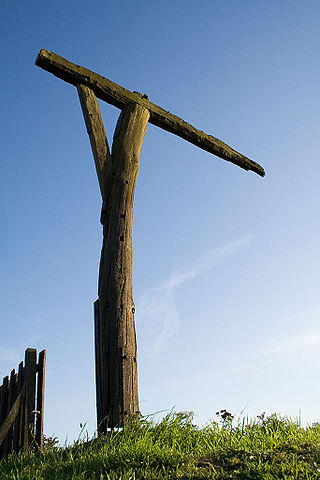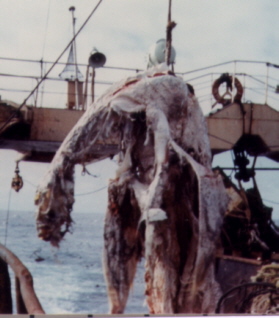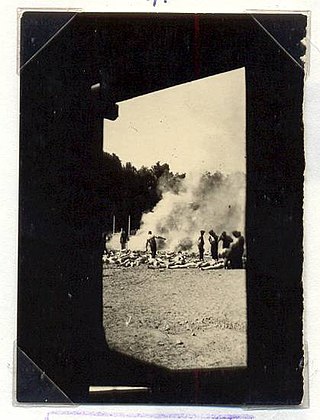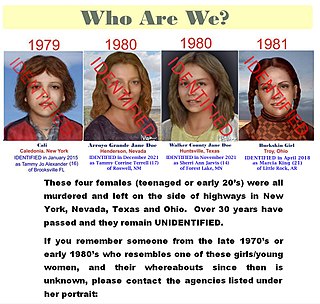
Embalming is the art and science of preserving human remains by treating them to forestall decomposition. This is usually done to make the deceased suitable for viewing as part of the funeral ceremony or keep them preserved for medical purposes in an anatomical laboratory. The three goals of embalming are sanitization, presentation, and preservation, with restoration being an important additional factor in some instances. Performed successfully, embalming can help preserve the body for many years. Embalming has a long, cross-cultural history, with many cultures giving the embalming processes religious meaning.

Gibbeting is the use of a gallows-type structure from which the dead or dying bodies of criminals were hanged on public display to deter other existing or potential criminals. Occasionally, the gibbet was also used as a method of public execution, with the criminal being left to die of exposure, thirst and/or starvation. The practice of placing a criminal on display within a gibbet is also called "hanging in chains".

David Hamilton was a British photographer and film director best known for his photography of young women and girls, mostly nude. Hamilton's images became part of an "art or pornography" debate.

Sally Mann is an American photographer known for making large format black and white photographs of people and places in her immediate surroundings: her children, husband, and rural landscapes, as well as self-portraits.
A body farm is a research facility where decomposition of humans and animals can be studied in a variety of settings. The initial facility was conceived by anthropologist William M. Bass in 1981 at the University of Tennessee in Knoxville, Tennessee, where Bass was interested in studying the decomposition of a human corpse from the time of death to the time of decay. The aim was to gain a better understanding of the decomposition process, permitting the development of techniques for extracting information such as the timing and circumstances of death from human remains. Body farm research is of particular interest in forensic anthropology and related disciplines, and has applications in the fields of law enforcement and forensic science. Numerous purposes exist for these research facilities, yet their main purpose is to study and form an understanding of the decompositional changes that occur with the human body. By placing the bodies outside to face the elements, researchers are able to get a better understanding of the decomposition process. This research is then used for medical, legal and educational purposes. Following the outdoor research, skeletal remains are cleaned and curated in permanent known skeletal collections open for research. Such collections are critical for testing and developing new identification methods.
Jacqueline Louise Livingston was an American photographer known for her work exploring woman's role as artist and person and investigating the boundaries of intimacy and propriety.
Disposal of human corpses, also called final disposition, is the practice and process of dealing with the remains of a deceased human being. Disposal methods may need to account for the fact that soft tissue will decompose relatively rapidly, while the skeleton will remain intact for thousands of years under certain conditions.

The Zuiyo-maru carcass was a corpse, caught by the Japanese fishing trawler Zuiyō Maru (瑞洋丸) off the coast of New Zealand in 1977. The carcass's peculiar appearance resulted in speculation that it might be the remains of a sea serpent or prehistoric plesiosaur.

William Richard Bradford was an American convicted murderer and suspected serial killer and serial rapist who was incarcerated in San Quentin State Prison for the 1984 murders of his 15-year-old neighbor Tracey Campbell and barmaid Shari Miller. In July 2006, the Los Angeles County Sheriff's Department released a compilation of photos found in Bradford's apartment in the 1980s, depicting 54 different women in modelling poses. As Bradford had used the promise of a modelling career to lure his known victims, and taken pictures of Miller before murdering her, police believe many of the photos depict Bradford's other victims in the moments before their deaths. Bradford died at the Vacaville prison medical facility on March 10, 2008, of natural causes.

Nude photography is the creation of any photograph which contains an image of a nude or semi-nude person, or an image suggestive of nudity. Nude photography is undertaken for a variety of purposes, including educational uses, commercial applications and artistic creations.
The University of Tennessee Anthropological Research Facility, better known as the Body Farm and sometimes seen as the Forensic Anthropology Facility, was conceived in 1971 and established in 1972 by anthropologist William M. Bass as the first facility for the study of decomposition of human remains. It is located a few miles from downtown Knoxville, Tennessee, United States, behind the University of Tennessee Medical Center, and is part of the Forensic Anthropology Center, which was established by Dr. Bass in 1987.

Arthur (Usher) Fellig, known by his pseudonym Weegee, was a photographer and photojournalist, known for his stark black and white street photography in New York City.
Blood Ties: The Life and Work of Sally Mann is a 1994 American short documentary film directed by Steven Cantor and Peter Spirer. It was premiered at the 1994 Sundance Film Festival and was nominated for an Academy Award for Best Documentary Short.

Rodney James Alcala was an American serial killer, rapist, and convicted sex offender who was sentenced to death in California for five murders committed between 1977 and 1979. He also pleaded guilty and received a sentence of 25 years to life for two further murders committed in New York. He was also indicted for a murder in Wyoming, although the charges filed there were dropped. While Alcala has been conclusively linked to eight murders, the true number of victims remains unknown and could be as high as 130.

Immediate Family is a 1992 photography book by Sally Mann. Images from the book were first exhibited in 1990 by Edwynn Houk Gallery in New York City. The book is published by Aperture and contains 65 duotone images. The book predominantly features Mann's three children, Emmett, Jessie and Virginia, when all were under 10 years old. Thirteen of the pictures show nudity and three show minor injuries; Emmett with a nosebleed, Jessie with a cut and stitches, and Jessie with a swollen eye from an insect bite. Many explore typical childhood activities at the family's remote summer cabin along the Maury River but others touch on darker themes such as insecurity, loneliness, injury, sexuality and death. Several images from the book were re-published in Mann's next book, Still Time.

Fine art nude photography is a genre of fine-art photography which depicts the nude human body with an emphasis on form, composition, emotional content, and other aesthetic qualities. The nude has been a prominent subject of photography since its invention, and played an important role in establishing photography as a fine art medium. The distinction between fine art photography and other subgenres is not absolute, but there are certain defining characteristics.

The Sonderkommando photographs are four blurred photographs taken secretly in August 1944 inside the Auschwitz concentration camp in German-occupied Poland. Along with a few photographs in the Auschwitz Album, they are the only ones known to exist of events around the gas chambers.

Unidentified decedent, or unidentified person, is a corpse of a person whose identity cannot be established by police and medical examiners. In many cases, it is several years before the identities of some UIDs are found, while in some cases, they are never identified. A UID may remain unidentified due to lack of evidence as well as absence of personal identification such as a driver's license. Where the remains have deteriorated or been mutilated to the point that the body is not easily recognized, a UID's face may be reconstructed to show what they had looked like before death. UIDs are often referred to by the placeholder names "John Doe" or "Jane Doe". In a database maintained by the Ontario Provincial Police, 371 unidentified decedents were found between 1964 and 2015.

A Harvest of Death is the title of a photograph taken by Timothy H. O'Sullivan, sometime between July 4 and 7, 1863. It shows the bodies of soldiers killed at the Battle of Gettysburg during the American Civil War, stretched out over part of the battlefield.

Death Makes the News: How the Media Censor and Display the Dead is a book by social and behavioral scientist Jessica M. Fishman. It was published in 2017 by New York University Press. The book focuses on the media's response to and portrayal of violent events, particularly when it comes to photographs. It also focuses on newsworthiness of tragedies, and comparisons in how different types of events, like natural disasters or mass murder, are covered, and the usage by relatives of victims of photos to attempt to get justice. The book itself contains photos of the dead in some cases, with the cover featuring the widely publicized photo of the assassination of Andrei Karlov.















